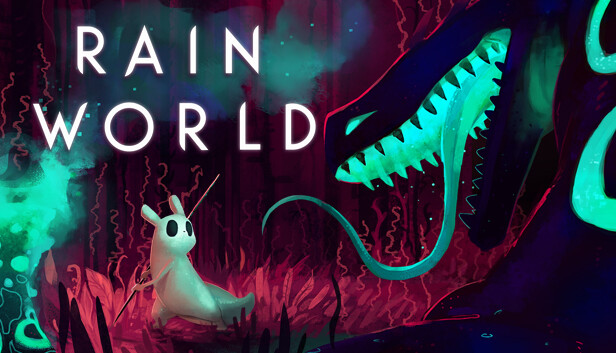For Rain World players, this guide is made to help all the newer players uncover the deep and complex systems that exist to create lizards in game
A General Overview of Lizards
Lizards are the most common species of predator; hardy and near-ubiquitous – found in 11 regions – they pose a threat to the player throughout the entire game. They are characterised by their typically black bodies and pulsing neon coloration.
Lizards boast the most variety of any creature type, having 9 distinct subspecies with their own abilities and attributes.

Typically, the red lizard has the highest stats out of any lizard but can only appear in hunter playthroughs naturally or through lineage in monk or survivor playthroughs. Otherwise, the green lizard, who appears more frequently has the second highest stats.
Below is a table showing the various stats of each lizards subspecies.
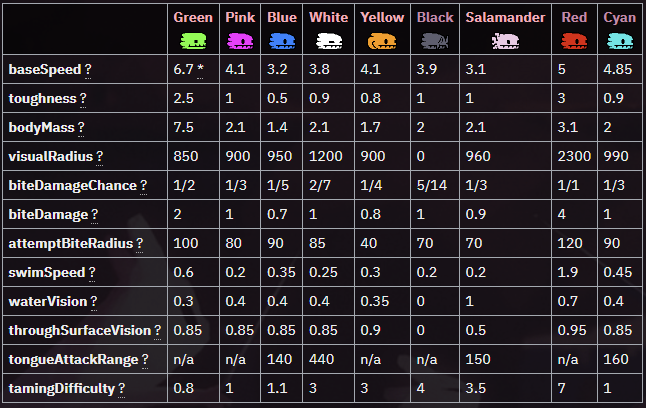
Relationships
These relationships are the default for all lizards, unless specified otherwise for a specific subspecies.

Green Lizard
The Green Lizard is one of the species of Lizards. They are usually the first lizard the player may encounter, and appear across many regions. Characterised by their lack of mobility and bigger size in comparison to other lizards, they are hefty, durable, and strong.TipsCombat
Fighting Green Lizards tends to be fairly easy on level ground, a hit to the face with Rubbish can stun and flip them over, exposing their soft bodies for an easy hit with a Spear . Evading their charge is also simple – the long, obvious wind-up gives ample time to prepare for a well-timed jump, backflipping or even just climbing onto higher ground. They are slow, making it hard for them to flee and thus leaving them open to further attack. However, they do have a very strong bite, and can be dangerous if faced when ill-equipped. They also possess the second-highest health of any lizard, and are capable of tanking many hits before dying – usually taking 5-10 spear hits to kill. After 3 hits they typically lose interest in pursuing prey and attempt to retreat to their den.
Stealth
Sneaking past Green Lizards is generally simple, as their line of sight often stays close to ground level. They tend to move in one direction continually, making it likely for them to bypass prey completely if they don’t have reason to investigate its general area further – avoid jumping repeatedly or throwing objects in their presence if trying to avoid detection. However, they are not easily distracted once locked onto prey.
Evasion
Green Lizards are rather slow, and clumsy with their attacks, making it easy to jump over them during a charge or even outrun them in a straight line. However, their lack of mobility can also often be deceptive, as they make frequent use of warp dens to reach places seemingly inaccessible to them. When in doubt, it is safest to seek higher ground such as high ledges or poles. The easiest way to avoid them is to simply crawl underneath them through pipes, or climb around above them.
Abilities & Behavior
Charge Attack
Whilst most lizards can charge at the player, Green Lizards have a special, stronger charge attack, signalled by a windup during which they hiss, before lunging forwards, biting anything that’s in the way. However, Green Lizards often perform this attack even if they are on lower ground compared to prey, or may even charge off a ledge, to miss. When they miss, it disorientates them for a brief moment, leaving the lizard vulnerable to a counter-attack. Green Lizards can charge much more frequently than other lizard types.
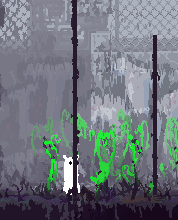
Mass
Green Lizards are the heaviest variety of lizard, making them immune to certain threats. However, this also comes at the cost of their ability to climb poles.
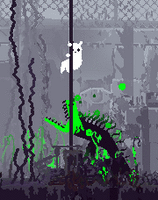
Taming
Green Lizards have the lowest taming difficulty, typically requiring 1-2 feedings.
Once tamed, they attempt to follow the player around and fight off threats. However, due to their high rivalry rating, they are very aggressive towards any other lizards, even other tamed lizards. In particular, they hate Cyan Lizard and other Green Lizards. They are a very loyal and durable lizard, and are very useful to tame despite their highly limited range due to their lack of mobility.
Trivia
- Green Lizards have the second strongest base damage per bite and second highest health, the first in both categories belonging to the Red Lizard.
- Ironically, and unlike most other lizards, Green Lizards are relatively fast swimmers and are much quicker over water, but are rarely found near it.
- Green Lizards are very aggressive towards other lizards, particularly towards other Green Lizards. This is due to their high “aggressive rivalry” stat, and they have the highest inter-species aggressiveness in the game.
- Hitting a Green Lizard with Rubbish while they are winding up for a charge attack can cause them to flip over and charge in the other direction.
- Green Lizards tend to be lazy, and may let prey get close to them or jump on their backs without lunging. Additionally, creatures that are directly in front of a Green Lizard’s face cannot be bitten by them.
- When falling, Green Lizards try to cling on to poles in an attempt to save themselves.
Green Lizards are uniquely resilient to several threats. - They are immune to Red Lizard bites, which results in them sometimes successfully killing Red Lizards.
- Tamed Red Lizards are able to attack Green Lizards without problems.
- Brother Long Legs cannot swallow them.
- Vulture ignore them and Vulture Masks only pacify instead of scaring them.
- Tamed Green Lizards can fight Vultures.
- King Vultures and their masks interact with Green Lizards as normal.
- Direct Centipedes shocks do not harm them, however they can die from shocks in water.
- They are immune to Worm Grass and strong enough to escape from Pole Plants.
Pink Lizard

The Pink Lizard (also referred to as Magenta or Purple Lizard) is one of the species of Lizards. They are one of the first lizards the player may see in the game, and likely the first variety encountered that can climb poles. They are found mostly throughout the early-game, but make a few rare appearances in later areas.Tips
Combat
Whilst not very durable, Pink Lizards make up for it with speed in close quarters. Unlike Green Lizard, getting near an uninjured Pink Lizard usually results in them instantly lashing out, and therefore caution must be taken when getting close to stab them – using Rubbish to stun and flip them before doing so is advised. Pink Lizards typically die after 2-4 Spear hits.Stealth
Pink Lizards have average vision, and do not usually look up above ground level unless they are climbing poles or hear something and decide to investigate the source, making stealth an effective choice against them. Throwing Rubbish to lure them away is typically sufficient to avoid them.
Evasion
Pink Lizards aren’t the fastest and can be outran on ground, but they do have degree of mobility. Particularly, they can be quite fast on poles, meaning that they have an advantage in long vertical rooms that can let them close the gap considerably.
Abilities & Behavior
Pink Lizards do not have any unique or exceptional abilities, rather serving as an introduction to lizards’ vertical mobility.
Pole Climbing
Like all lizards except Green, Pink Lizards can climb up poles.
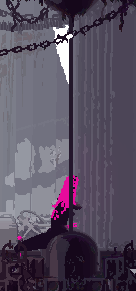
Taming
Pink Lizards have average taming difficulty, typically requiring 1-3 feedings.
Pink Lizards, whilst loyal and unlikely to get into unnecessary fights, are not very powerful or durable, and for the most part are incapable of reaching the gates into different regions to boot, making them poor picks for long-term companionship.
Trivia
- Pink Lizards have some of the widest hue variation of any lizard.
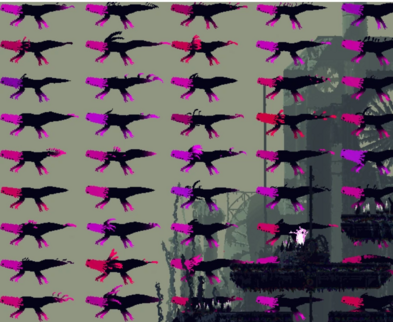
- Pink Lizards were designed to be the “average” lizard, not being particularly strong, durable, fast or good at climbing, nor possessing any special abilities.
- Lizard breed statistics are balanced around this, with Pink Lizards typically being assigned as a baseline 1.
- However, they do have the slowest base swimming speed of all lizards.
Blue Lizard

The Blue Lizard is one of the species of lizard. They appear predominantly in the early-game, with some rare appearances in the mid- and late-game. They are the smallest, weakest lizard, being preyed upon by some other lizards, and are likely the first wall-climbing lizard the player may encounter.Tips
Combat
Blue Lizards are not very durable, making combat an effective choice against them – even one single Spear icon.png Spear hit is enough to nearly kill them. However, it can be tricky to get a good angle on them due to their ability to climb on walls. Hitting them causes them to fall off the wall, granting an opening to attack, and baiting them into an area where they are forced into a chokepoint and hitting them with Rubbish icon.png Rubbish to flip them over, then stabbing them, is a good strategy to dispatch them with. Additionally, a Blue Lizard latching on with its tongue grants a good opportunity to easily throw a spear into its mouth. Blue Lizards only take 2 Spear hits at most to kill, and frequently bleed out after only one.
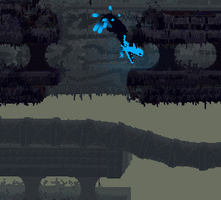
Stealth
Blue Lizards have worse hearing and vision than other wall climbing lizards, making it possible to sneak around them with ease. They usually stick to climbing around the borders of rooms, but may deviate if they’re tracking down something. Throwing Rubbish or using some kind of other sound distraction usually keeps them busy for long enough to get past.
Evasion
Blue Lizards are not the fastest lizard, but make up for it with their mobility. Running away from them in horizontal rooms is relatively easy, but if going upwards they can quickly close the distance, thus it’s recommended to stay away from vertical climbing sections when evading them. Hitting them with a rock or spear stuns them momentarily, causing them to drop off the wall and potentially buying time to get away.
Abilities & Behavior
Wall Crawl
Blue Lizards are able to walk on room backgrounds, giving them much more mobility than the average lizard. Hitting them whilst they are walking on walls knocks them off.
Tongue
Blue Lizards possess a short tongue with which they can latch onto their prey. When their tongue has hit something, they are immobilised until they have either successfully reeled in their prey or they get stunned.
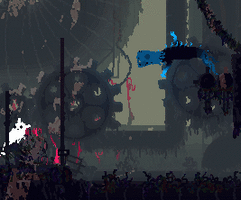
A Blue Lizard using both abilities to attack the player.
Taming
Blue Lizards have average taming difficulty, typically requiring 2-4 feedings.
Blue Lizards can be taken across many regions due to their wall climbing, but have very little power or durability, meaning that should they attempt to fight other creatures they will most likely die. For this reason, they are not very good picks for companionship beyond being a meat-shield.
Trivia
- Blue Lizards have the lowest toughness and bite lethality of all lizard species.
- Blue Lizards are frequently hunted and eaten by Green Lizard. Cyan Lizardare also seen hunting and eating them.
- Other lizard varieties also have a tendency to bully them.
- Blue Lizards have the ability to walk on ceilings, unlike White Lizard. This is a trait shared with Cyan Lizards.
- Blue Lizards appear to prefer Adult Centipede as prey.
White Lizard

The White Lizard is one of the species of lizard. They predominantly appear throughout many early to mid-game areas and pose a significant threat to a player unaware of their surroundings. They have the unique ability to camouflage, blending in with backgrounds, and incredibly long tongues to catch their prey with.Tips
Combat
Whilst White Lizards are not particularly tough, only taking 2-4 Spears to kill, they have significant positioning advantage. The key to fighting them, therefore, is to stay as level as possible with them, as they are very difficult to fight in a vertical situation due to the advantage their long tongue gives them. As with most Lizards, their head is armored, so it is recommended to flip them with Rubbish to the head and then throwing a Spear, or ambushing them from a favorable angle. If facing them head on, it’s possible to use their tongue against them, as they are rendered more or less immobile while reeling prey in with it. If they are climbing against a background wall when speared or hit with Rubbish, they are momentarily stunned, letting go of the wall – if clever positioning is utilised, this can be used to drop them over a death pit, instantly killing them once they drop off-screen.
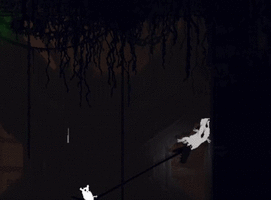
Stealth
White Lizards usually position themselves to have a good view of the room they are currently in, making it hard to sneak past them. Additionally, their camouflage can make it hard to even know where they are, making stealth against them difficult. They are pointed out by the Overseer sometimes, but their location can also be discerned by looking for their eyes, teeth, and body outline against the background as their camo isn’t perfect, or by making enough noise to get them to salivate – as ambush predators, they tend to stay stationary when not actively pursuing prey and are very unmotivated to investigate noise, making this a viable strategy. It should be noted that in some areas their camouflage does not work very well.
Evasion
White Lizards are easily able to keep up with their prey due to their ability to take shortcuts across walls, so great care must be taken when trying to escape from them. Throwing rocks at them stuns and knocks them off the background wall, slowing them down significantly. If grabbed by the lizard’s tongue, getting close to them or throwing something at them causes them to let go. White Lizards, while fast, tend to give up easily and usually stop pursuing if they lose track of their target, instead opting to set up an ambush.
Abilities & Behavior
Wall Crawling
White Lizards possess the ability to walk on background walls. This makes them a difficult enemy to evade, especially due to their high speed. Even more troublesome is their habit of camouflaging themselves in the background walls of narrow passageways, making it easy to stumble into them by accident.
Camouflage
When idling, White Lizards mimic the color of the background they are standing on, often rendering themselves near invisible save for their eyes and mouth. They stay motionless, waiting for prey to pass them by. Once they have spotted potential prey, a White Lizard emit particle effects, often giving their location away. When their prey has wandered close enough, their camouflage fades away as they lash out in an attempt to capture it, either with their long tongue or strong jaws. This camouflage is not infallible however; any damage to their body results in their coloration going haywire, losing the ability to camouflage themselves effectively for the cycle.

Tongue
When ambushing or pursuing prey such as the player, White Lizards may employ their long tongue to try and snag them. Once their tongue has hit something, they are immobilised as they attempt to reel it in so that they can bite it. If struck by Rubbish or a Spear, it causes them to release whatever they are latched onto.

Taming
White Lizards have higher than average taming difficulty, typically requiring 2-4 feedings.
White Lizards can follow the player through many regions due to their ability to wall-climb, and can be advantageous to bring into Shaded Citadel from Industrial Complex as their full-body glow can illuminate the area around them to a certain degree. However, they’re not particularly good at combat with other creatures due to their tendency to hang back and rely on their tongue rather than engaging in directly fighting.
A recommended place to tame White Lizards is the big vertical room with a pearl, and more importantly two White Lizards on the right side of Industrial Complex, near the gate to Shaded Citadel. Below this room are tunnels with Baby Centipedes, which can be killed easily by taking a single bite out of them for easy transport into the room above.
Trivia
- White Lizards are the only terrestrial Lizard species to have a white body, rather than a black one. They are also the only Lizard to have a pure black head.
- Additionally, they are one of two Lizard species to not have any hue variation, the other being Black Lizards.
- They are the only Lizard species present in the subregion The Leg, and co-inhabit the rest of The Exterior with Yellow Lizards and (if playing as the Hunter) Cyan Lizards.
- They have a very low rivalry rating among members of their own species, beaten only by Cyan, Black and Yellow Lizards.
- The White Lizard’s tongue can cause some weird physics interactions, particularly it can sometimes be used to slingshot the player.
- When a White Lizard latches onto an object below it with its tongue, due to gravity pulling the object down it may become stuck and unable to release it until hit.
- White Lizards’ unique coloration are tied to their camouflage – when their camouflage is removed, they bear similar coloration to other Lizards, having black bodies and white heads.
Yellow Lizard
The Yellow Lizard (also referred to as Orange Lizard) is one of the species of lizard. Characterised by their long antennae and ability to coordinate and hunt in packs of 2-5, they are a common mid- to end-game threat.TipsA Yellow Lizard falling to its death
Combat
Yellow Lizards are not particularly strong individually, typically only taking 3-6 Spears, and are clumsy, but have strength in numbers and can quickly surround or corner prey; having to consider positioning and movement in relation to so many creatures can quickly become complicated. It’s best to try to single out one and dispatch of it quickly before the rest of the pack can arrive to help it out. Killing the alpha disrupts their ability to coordinate, but it may be hard to distinguish them from normal pack members.
Vulture Masks are somewhat of a double-edged sword when it comes to Yellow Lizards – when a Yellow Lizard is affected by one, the entire pack panics and flees, potentially scattering a group of them and allowing for clear passage. However, this means that their cooldowns also all wear off at the same time and individuals can no longer be affected by it again even if they didn’t personally see the mask, rendering it useless if one who has already experienced the effects is encountered.
Stealth
Whilst Yellow Lizard packs have many eyes, they do not have the best vision or hearing. They are also frequently found in places with many tunnels and alternative routes, providing plenty of options to sneak around them. However, once a single Yellow Lizard spots prey, every one begins making its way to that location.
Evasion
Outrunning Yellow Lizards is mainly a task of avoiding being cornered as they are not particularly fast. In the case of getting surrounded, it’s possible to backflip or jump above their heads due to their slow reflexes. Additionally, they are very commonly found around vertical places with death pits – combined with their clumsiness, they frequently fall to their deaths whilst giving chase.
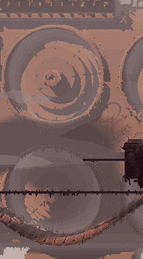
Abilities & Behavior
Telepathy/Pack Hunting
Yellow Lizards can telepathically communicate with their fellow packmates – when one Yellow Lizard sees prey, every single member of the pack is informed of its location. With this, they coordinate to surround and corner whichever creature they’ve set their sights on.
Each pack has an alpha, typically assigned based on the dominance personality value, and tend to have the longest antennae out of their entire pack. When the alpha is killed, the entire pack loses its ability to communicate with one-another.
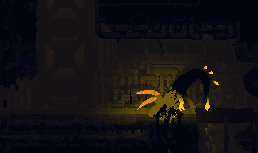
Communicating telepathically
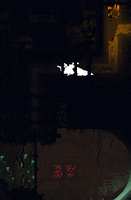
Surrounding their prey
Taming
Yellow Lizards have higher than average taming difficulty, typically requiring 2-4 feedings.
Taming Yellow Lizards is not particularly different from taming Pink Lizards in terms of difficulty. When tamed, they are separated from their pack and become aggressive towards any other lizard – including former packmates. Tamed Yellow Lizards will not communicate with other Yellow Lizards either. Note that taming an alpha does not tame the entire pack, and will simply separate it from the group instead, like with any other Yellow Lizard.
Trivia
- Yellow Lizards, as pack hunters, naturally have no inner-species rivalry.
- If a Yellow Lizard thinks it is in a pack of 0 lizards, it crashes the game.
Black Lizard

The Black Lizard (also known as Mole Lizard) is one of the many species of Lizards. They are one of the rarest lizards, only appearing in two regions, and are also the only species of lizard to have no vision.Tips
Combat
Black Lizards have average durability, taking only 2-4 Spears to kill, as well as sluggish movement and reflexes, making them relatively easy to kill. Slide-spearing is a particularly effective choice against them due to the fact that they cannot see and therefore cannot react in time to bite. However, they are often found in narrow tunnels and pipes (especially in Subterranean), meaning it can be hard to get a good shot at them. Additionally, whilst they do not form packs, there are usually multiple in each room they are found in, and attempting to kill one may attract the others.

Slugcat slide-spearing a Black Lizard.
Stealth
Given their complete reliance on hearing, Black Lizards are easy to elude if care is taken to avoid making noise – they are typically found in areas with many tunnels, which can be moved through silently. That being said, it’s often difficult to know where exactly they are; their environments usually mask their location, which makes it hard to predict their movements. Keep an eye out for any grey flashes in the dark: this means they have heard something and are on their way to investigate the noise. If blocking the way, it’s best to throw Rubbish to bait them into another area and move past them whilst they investigate; they are very noise-motivated.
Evasion
Black Lizards are very easy to outmaneuver due to their average mobility – the main challenge is avoiding being cornered by them, and balancing speed with quietness. Throwing Rubbish or a Spear in a different direction encourages them to investigate the sound, giving an opportunity to slip by.
Abilities & Behavior
Advanced Hearing
In order to make up for their blindness, Black Lizards have an incredibly keen sense of hearing, being able to hear almost any noise made in the room they’re in, and quickly honing in on the location of its source. Whenever they hear something, their head lights up and they begin to make their way to the origin point of the noise. If they do not find a creature at that position, the Black Lizard begins to search the nearby area for it.

Head lighting up
Taming
Black Lizards have higher than average taming difficulty, typically requiring 3-5 feedings.
Black Lizards cannot follow the player into different regions, nor do they have an exceptional amount of power or durability. They can potentially act as a detection system of sorts, as they light up whenever they hear any sound, but due to the fact that they still light up when the player makes noise even when tamed limits the usefulness of this when on the move.
Trivia
- Black Lizards are one of two lizard species to not have any hue variation, the other being White Lizards.
- Black Lizards have the second lowest aggressive rivalry stat between lizard types, behind Y Yellow Lizards. Because of this, Black Lizards appear to be more tolerant of living with their own kind than other lizard species, and very rarely fight each other.
- In addition to this, there are frequently multiple of them in the same room – up to 16 can be found in a single room.
- Due to their blindness, it is possible to get incredibly close to black lizards without drawing aggression, even if not tamed.
- Some Black Lizards have eyes that are visible when their heads light up. Due to this having no impact on their vision, it can be assumed that they are non-functional.
Salamander

The Salamander, also known as the Axolotl, is an unusual amphibious creature, seemingly related to Lizards. It is capable of moving both over land and swimming through water, unlike their terrestrial cousins who can only float on it.Tips
Combat
Fighting Salamanders presents a unique dimension of complexity due to the fact that they are typically encountered in and around water, which gives them a significant advantage in terms of movement and offensive ability. If possible, never directly engage with a fight with a Salamander in water – they are not very visible when underwater, making it hard to locate them, and submerged Spears lose their velocity quickly and do not hit. Luring them back to dry land and engaging there is the best choice. Otherwise, they are not particularly different from a Pink Lizard (other than their tongue) and typically die after 2-4 Spear hits.
Stealth
Salamanders are often found blocking vital pathways and are typically found in areas that offer little options in the way of stealth, making it a hard option to employ against them. Avoid attempting to sneak around them in water – they have the speed and vision advantage, and are camouflaged in deeper water, making it difficult to spot them approaching until it is too late.
Evasion
Salamanders have average mobility on land, making them generally easy to avoid and outrun. However, it is more difficult when underwater due to their enhanced swimming ability. It is possible to slip past a Salamander by quickly diving beneath them and resurfacing in a semi-circular pattern, but this does not work in shallower pools. In this case, luring them towards land where they are slower and moving around them there is a good option. If caught by their tongue, hitting them with a Spear or Rubbish stuns them.
Abilities & Behavior
Swimming
Salamanders have superior swimming capabilities and are able to swim much faster than they walk. They can be difficult to see when deep underwater, meaning they are able to spot and catch prey off guard if caution is not used. Out of water, they have average speed, and are able to climb up poles.
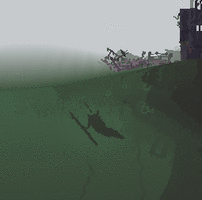
Water Vision
Salamanders can see perfectly underwater, but take a 50% vision penalty when looking into water from the surface.
Tongue
Salamanders have a short, sticky tongue which can reel in prey from a close range.
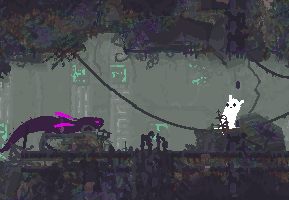
Taming
Salamanders have higher than average taming difficulty, typically requiring 3-4 feedings.
Salamanders could be considered a better option than most other lizards for areas with water due to their unique ability to swim. However, they are not particularly strong, and do not offer much in the way of defence. Additionally, the reputation lost by gathering Jetfish and Scavengers to feed to them may make things more difficult, either due to a lack of available mobility options or the low reputation enticing them to attack.
Trivia
- Curiously, despite being adapted for aquatic terrain, the code suggests their movement speed in water is only 0.2, which is a trait shared by Pink, Black, and White Lizards. The fastest swim speed in the code is the Red Lizard at 1.9. It is worth noting that terrestrial lizard species avoid going in water if they can, and are incapable of diving downwards of their own accord.
- Salamanders cannot be lineaged in their non-native regions, and are not a part of the Dragonslayer passage.
- Salamanders can appear as varying shades of purple, pink and red when going through pipes, which may be confused with Pink Lizards.
- Neither variety of Leech attack salamanders.
- Salamanders snap at any Batflies that linger around them, potentially killing them.
Red Lizard

Red Lizards are the largest, most aggressive and dangerous species of Lizard that can be encountered in-game. They are only found natively in a few places as Hunter and can be lineaged as Monk or Survivor.Tips
Combat
Red Lizards are by far the most difficult and time-consuming lizard to fight due to their tenacity, speed, ability to disarm with their projectile spit, and resistance to injury – they can take 6-12 Spears before dying. Additionally, hitting them with Rubbish does not flip them over like other lizard breeds, and they are very resistant to explosives. Hitting Red Lizards with a Spear to the mouth with techniques such as crouch- or slide-spearing stuns them for a longer than average period, granting the opportunity to get some free hits in at their body, and explosives may also be used to stun them for a moment. A tamed Green Lizard can be a valuable ally to have when fighting Red Lizards due to their immunity to Red Lizard bites.
Stealth
Sneaking past Red Lizards is next to impossible due to their heightened senses of vision and hearing; they can hear and see prey from far off-screen and do everything in their power to make their way towards their quarry. Additionally, they are typically found in long, flat stretches of terrain, giving few options for sneaking around them.
Evasion
Due to their speed, evading Red Lizards can be quite difficult – they can catch up in the blink of an eye. If a Red Lizard is in the way, always retreat to a location where it’s easier to manoeuvre around them. Getting to sheltered high ground is recommended due to Red Lizards being reliant on poles and creature tunnels, but must be done quickly as Red Lizards may utilise their projectile spit to knock prey off poles and high ground. If running away from a Red Lizard, it is possible to utilise the knockback from their projectile spit to boost towards an exit. Additionally, finding a group of other creatures such as Squidcadas, Scavengers, or even other Red Lizards may distract them, buying time to get away safely. This combined with advanced movement, such as slides, also helps in outpacing them.
Abilities & Behavior
Projectile Spit
Red Lizards have the unique ability to spit projectiles at their prey. Whilst the spit itself does not deal damage, it causes a large amount of knockback, weighs down whatever it is attached to, and can even disarm the player. The projectiles have an impressive range, but Red Lizards must stop moving to shoot them.
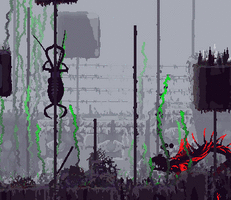
Fearlessness
Red Lizards are not afraid of Vultures or King Vultures, and subsequently are not affected by their respective Masks.
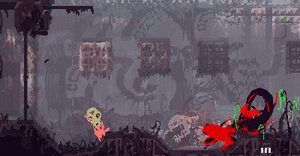
Taming
Red Lizards are the most difficult and time-consuming lizard to tame, typically requiring 7-9 feedings. Care must be taken when feeding due to their speed and aggressiveness. They are capable of fending off the vast majority of threats, and will keep fighting until killed, but cannot climb on backgrounds and so have difficulty pathing through some rooms and consequently between regions. Mostly-tamed red lizards will follow the player relentlessly and can still bite and kill Slugcat, which is an issue in shelters. Biting can also happen accidentally with fully tamed lizards.
When playing as Monk or Survivor they must also first be lineaged.
Trivia
Red Lizards fighting
- Unlike most other creatures only found natively as Hunter, Red Lizards were present in the game before the 1.5 update, but could only be encountered via the lineage system.
- Red Lizards have the highest visual range, swimming speed, and vision when looking into water from the surface of any lizard.
- This technically makes them better at swimming and looking into water than Salamanders, who have 0.2 speed and 50% vision compared to Red Lizards’ 1.9 speed and 95% vision. However, Red Lizards cannot dive.
- They move so quickly in water that the water around them is displaced.
- Red Lizards attack others of their kind on sight with an extreme aggression not exhibited by any other breed, almost always resulting in a fatality. They are mostly neutral towards other lizard breeds.
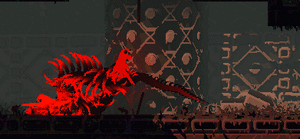
- Unlike any other lizards, Red Lizards attack – and often kill – King Vultures (and even Miros Birds, though this interaction does not often occur naturally). Additionally, Dropwigs and Big Spiders, who usually attack all other lizard types, attempt to flee from Red Lizards.
- Even if a Red Lizard is holding a corpse in its mouth, it can still fire projectiles.
- Red Lizards are capable of biting every frame.
- There is a 1/10,000,000 (one in ten million) chance that a Red Lizard’s bite may fail.
Cyan Lizard
The Cyan Lizard (also known as Leapzard or Leap-lizard) is one of the many species of lizard. They are the most mobile lizards, possessing all of the climbing abilities of a Blue Lizard or White Lizard, while also being capable of launching themselves at high speeds. As one of the hard-mode enemies, they are found natively across many regions as Hunter, and may be lineaged as or Survivor.Tips
Combat
Whilst Cyan Lizards are fast and aggressive, they do not have much health, taking 2-4 spears to kill; therefore, the main difficulty lies in managing to get a good shot at them due to their high mobility. Stunning them with a rock knocks them off any walls and prevent them from leaping, giving an opportunity to hit them with a spear. Hitting them with a projectile whilst they are in mid-air also prevents them from grabbing onto anything for a few seconds, potentially leading to them falling to their deaths.
Stealth
Cyan Lizards tend to stay on the move, patrolling areas quickly, making it easy to lay in wait for one to move past and sneaking behind it. They also are common in areas with many alternative paths and places to hide.
Evasion
Cyan Lizards are some of the most difficult lizards to directly run away from as they excel in moving in all directions. The best way to evade them is to trick them into going a different direction than the way forwards, then using the opportunity to slip past. Vulture Masks are particularly invaluable in warding off Cyan Lizards as due to their high speed, they run away significantly faster compared to other lizards, giving more breathing room once the mask’s effect wears off.
Abilities & Behavior
Wall Crawl
Cyan Lizards can crawl along the background walls, and are capable of grabbing onto them at any point whilst falling through the air unless stunned.
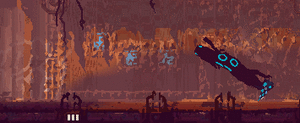
Leap
Cyan Lizards are able to launch themselves using their tails, allowing them to traverse distances very quickly. They perform a short windup, during which their tail is held stiff and vibrates and, depending on how long they charge up, they may perform either a single leap that launches them a great distance, or sequences of shorter, rapid-fire leaps. Both can be chained together, and propel them through the air until they hit the ground or grab onto a wall.

Tongue
Cyan Lizards possess a short tongue which they can use to latch onto and reel in prey.

Taming
Cyan Lizards have average taming difficulty, typically requiring 2-3 feedings.
Cyan Lizards are a good pick as a long-term companion – unlike other lizard species, they are capable of entering every region (though they most likely won’t get far in Shoreline). However, combat in conjunction with a Cyan Lizard can be challenging at times due to their tendency to leap everywhere combined with low health making it easy to accidentally hit and kill them. That being said, they are capable of contributing a modest amount of damage to fights with other creatures, and are also decent at saving the player when incapacitated in another creature’s jaws as their leap allows them to catch up to and bite at it quickly.
A good place to tame Cyan Lizards is around the right-most hub of Sky Islands, just before the bridges leading to Chimney Canopy; on Hunter mode there are plenty of Squidcadas available and a single Cyan Lizard den in the same room, making it trivial to tame one within a cycle due to their low taming requirement.
Trivia
- When hit by a spear whilst in the middle of a leap or preparing for one, their leaping ability may go haywire, leaking an unknown gas from the wound and flying around similarly to a deflating balloon.
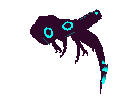
- This has a 25% chance to occur with hits to the head, and 50% for other body segments. It can only happen to an individual cyan once in a cycle.
- This frequently ends up throwing them into death pits in Sky Islands, Chimney Canopy and The Exterior.
- Curiously, whatever reaction that occurs inside the tail that allows Cyan Lizards to leap generates enough heat to distort the air around it.
- Cyan Lizards will hunt and eat Blue Lizards.
- Cyan Lizards have the ability to walk on ceilings, unlike White Lizards. This is a trait shared with Blue Lizards.
- Cyan Lizards have one of the lowest same-species rivalry levels, beaten only by Black Lizards and Yellow Lizards.
